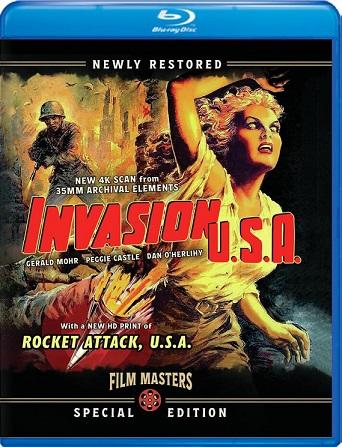Two Cold War films + Peckinpah’s ‘Wild Bunch’
Invasion, U.S.A. (1952, Film Masters, 2 Blu-rays, NR, 73 min.). This newly-restored edition includes both the title film and 1960’s “Rocket Attack U.S.A.” (83 min.), both then timely Cold War warnings of our Communist enemies launching surprise atomic bomb attacks on the United States. While neither film is particularly good, they probably had more impact when first released and some of the bonus material is worth watching.
Much of “Invasion, U.S.A.” is set in a New York City bar as the few patrons watch TV news broadcasts about 500 enemy planes attacking Alaska, including dropping three nuclear bombs. Later there are views of the bombings of San Francisco and the Boulder Dam. Finally, in the last 20 minutes, New York City is bombed.
The TV newsman, who also shows up at the bar, is Vince Potter (Gerald Mohr of “The Angry Red Planet,” “Funny Girl,” TV’s “Bonanza”). Other bar patrons include a man who manufactures tractors in San Francisco – but the military would rather he build tanks – and a congressman. While the enemy is not named, at one point it is said that enemy soldiers were transported on ships flying six different national flags.
The film uses lots of World War II airplane attack footage, but there is little sense of real danger, despite attempts to move a few of those in the bar back to their homes. Spoiler alert: The film actually wimps out by having the whole attack be a fantasy generated by a hypnotist, who also was drinking at the bar.
The film was directed by Alfred E. Green (“The Jolson Story,” “Strange Affair”).
Extras include a remembrance of Gerald Mohr’s career by his son, Tony Mohr, who points out his dad played Philip Marlowe on the radio (18 min.); a review of Hollywood versus Communism, including the Committee of Un-American Activities Blacklist and looks at Cold War films, such as the two in this collection (36:06); the 1951 short, “And a Voice Shall Be Heard” (21:33), which centers on Syracuse, N.Y. and often was theatrically shown on the same bill as “Invasion, U.S.A.”; a stills gallery (2:15); audio commentary by author and professor Jason A. Ney; and six Atomic-era propaganda shorts (combined with the two additional ones on the second disc, they equal 115 min.).
The second film, “Rocket Attack U.S.A.,” has more of a cloak-and-dagger plot, as U.S. spy John Manston (John McKay of “Cuban Rebel Girls”) is sent into Russia to spy on the Soviets’ intercontinental missile program. His Russian contact is Tanya (Monica Davis of “The Road Hustlers), who just so happens to be sleeping with the Russian Minister of Defense, who talks when he gets drunk.
The U.S. problem is their intercontinental missiles keep blowing up after launch, so our military panics when it learns Russia plans to launch a nuclear strike against New York City. Manston is to attach a bomb to the Russian rocket, destroying it.
Despite the Russian launch site being ridiculously under-guarded, Manston fails in his mission. The rocket is launched and New York City is hit by an atomic bomb, killing 3 million inhabitants.
The film, written and directed by Barry Mahon (“Jack and the Beanstalk,” “Run Swinger Run!”), suffers from an anemic budget and far too-dark action at the Soviet missile site.
Extras include audio commentary by film historians C. Courtney Joyner and Mark Jordan Legan; and the Mystery Science Theater 3000 episode on the film (97 min.). There also is a 24-page, full-color booklet with essays by Don Stradley and Toby Roan. Grade: “Invasion, U.S.A.” 2 stars; “Rocket Attack U.S.A.” 1.25 stars; extras 2.75 stars
Rating guide: 5 stars = classic; 4 stars = excellent; 3 stars = good; 2 stars = fair; dog = skip it
The Wild Bunch: The Original Director’s Cut (1994, Warner Bros., Blu-ray, R, 144 min.). Director Sam Peckinpah’s (“Ride the High Country,” “Pat Garrett & Billy the Kid,” “Straw Dogs”) masterful film was first released in 1969 at 135 minutes. In 1994, it was reissued in this restored director’s cut. The film, which brought extreme violence to the Western film, and films in general, is about an aging group of outlaws in 1913 Texas who are looking for one last big score.
The film opens with a bank robbery that actually was a disguised trap for the gang led by Pike (William Holden of “Stalag 17,” “Sunset Boulevard,” “Network”). However, as a singing parade of Temperance followers approaches the bank, one of the robbers notices three rifles on the roof across the street. In the firestorm that follows, only one robber is killed, but so are dozens of townspeople and several of the railroad-hired would-be attackers, who are led by Deke Thornton (Robert Ryan of “The Dirty Dozen,” “Clash by Night”).
Pike’s gang includes Dutch (Ernest Borgnine of “Marty,” “The Poseidon Adventure”), Mexican Angel (Jamie Sanchez of “Carlito’s Way,” “The Pawnbroker”), Lyle Gorch (Warren Oates of “Stripes,” Peckinpah’s “Bring Me the Head of Alfredo Garcia”) and Tector Gorch (Ben Johnson of “The Last Picture Show,” “The Getaway”). They head to Mexico, after they realize the bank job was a setup, as the bags they stole only held worthless machine washers.
Meanwhile, railroad official Harrigan (Albert Dekker of “Kiss Me Deadly,” “Gentleman’s Agreement”) gives Thornton a 30-day deadline to capture Pike or face going back to prison in Yuma.
While in Mexico, Pike’s gang encounters Mexican General Mapache (Emilio Fernandez of “Pat Garrett & Billy the Kid”), who has a couple of German army advisors, including Mohr (Fernando Wagner of TV’s “Cartas de amor”). Pike agrees, for $10,000, to rob a train carrying 16 crates of rifles and ammunition intended for the U.S. military. Mapache is a rogue general during the Mexican revolution.
The robbery execution is quite clever and leads to an exciting river bridge blow-up. Also onboard is a machine gun, which Pike gives to Mapache, but his men do not mount it on a tripod and it goes off crazily, killing many innocents and soldiers.
A subplot involves Angel wanting to get back at Mapache, who had stolen his girlfriend, and Angel agreeing to help rob the train for one crate of rifles to arm his fellow villagers against the Mapache’s army. Angel’s own mother rats on him and Pike has to turn over Angel to Mapache, who has Angel hauled through town by a horse, while children jump on him.
Finally realizing there is not much left for them, Pike and Dutch decide, with the other remaining gang members, to go rescue Angel, which leads to the climatic bloody shootout as they take on the Mapache’s army.
At the time, the film was quite violent, but since then film violence has become rather routine.
Extras include audio commentary by Peckinpah biographers/documentarians Nick Redman, Paul Seydor, Garner Simmons and David Weddle; “Sam Peckinpah's West: Legacy of a Hollywood Renegade” (82:35), narrated by Kris Kristofferson, first shown in 2004 on the Starz Encore network, the in-depth biography was carefully assembled from mostly contemporary interviews and points out Peckinpah used stylized violence in an era of the Vietnam War and political assassinations in the U.S.; “The Wild Bunch: An Album in Montage” (33:29), this 1996 Oscar nominee for best short documentary was written, directed and edited by Seydor, and produced by Seydor and Redman, both of whom appear on the commentary track too; an excerpt from “A Simple Adventure Story: Sam Peckinpah, Mexico and the Wild Bunch” (23:46), visiting the Mexican sites used in the film; outtakes from the film (8:46); and a trailer gallery of five Peckinpah Western films (15:58). Grade: film 4.5 stars; extras 4 stars
Tarzan of the Apes (1918, Film Masters Archive Collection, Blu-ray, NR, 65 min.). This was the first Tarzan filmed adventure, which stuck very close to Edgar Rice Burroughs’ original concept of the character, although filmed in Louisiana rather than Africa. The bonus film, also starring brawny Elmo Lincoln as Tarzan, is “The Adventures of Tarzan” (1928, 67 min.). Lincoln played Tarzan in three films and appeared in a fourth Tarzan films, as well as “The King of the Jungle.” Both films are silents.
The first half of “Tarzan of the Apes” deals with Tarzan’s parents traveling to Africa, as Lord Greystoke (True Boardman) is sent by British authorities to suppress Arab slave trading in British Africa. His wife Alice (Kathleen Kirkham) joins him. Both are marooned on the African coast after a mutiny aboard their ship. Sailor Binns (George B. French) helped them survive the mutiny, but Binns is taken by Arab slavers and is tortured for the next 10 years.
Meanwhile, Alice gives birth to the boy who will become Tarzan, but she dies, leaving the child with no one to nurture him. A despairing Lord Greystoke does not last long either, but the mate of ape Kala finds the child and gives him to Kala to raise.
Most of this first half hour features a naked Gordon Griffith as the child Tarzan, who finds an illustrated language book in the Greystokes’ cabin, as well as a knife that he uses to kill a menacing lion. Tarzan later steals clothes from two tribal boys.
When Binns escapes, he joins the boy Tarzan, until leaving for England to find the boy’s relatives. When the relatives arrive, they encounter the adult Tarzan, who helps protect them and his future wife Jane Porter (Enid Markey) from an aggressive native tribe.
In “The Adventures of Tarzan,” large chunks of plot are not shown, but rather mentioned on cards. In general, the story has to do with Jane (now played by Louise Lorraine) being captured multiple times by Russian Secret Service agent Rokoff (Frank Whitson), who, at one point, draws a map to the fabled treasure of Opal on her shoulder. Rokoff is obsessed about stealing Queen La’s (Lillian Worth) treasure.
Rokoff is aided in his nefarious activities by Hagar the Beggar, who manages to temporarily capture Tarzan and Jane with his staircase that turns into a slide, and Rokoff’s assistant Gernot (Zip Monberg).
In Burroughs’ books, Opar is a complete hidden city, but here it is mostly reduced to a cave that is holding the treasure. La tries to enlist Tarzan to lead her soldiers against Rokoff and his men. Grade: “Tarzan of the Apes” 3.5 stars; “The Adventures of Tarzan” 2.75 stars
Patterns (1955, Film Masters Archive Collection, Blu-ray, NR, 83 min.). This film first aired in January 1955 on Kraft Television Theater. The teleplay and story were by Rod Serling (later of “The Twilight Zone” fame) and won him the first of his six Emmy Awards.
The business boardroom-oriented story has Fred “Red” Staples (Van Heflin of “Shane,” “Possessed”) join the large firm, Ramsey & Co., led by Walter Ramsey (Everett Sloane of “Citizen Kane,” “The Lady from Shanghai”), a take-no-prisoners kind of guy. Staples is assigned to work with 30-plus-years employee Vice President Bill Briggs (Ed Begley of “12 Angry Men,” “Hang ‘Em High”), not initially realizing he was hired to eventually replace Briggs, whose ideas Ramsey looks down on.
Ramsey and Briggs often clash during board meetings, such as when Briggs had reservations about how a new factory acquisition was being done, as it would put 900 men – half the town – out of work for six months.
Staples reaches his own breaking point when Ramsey refuses to acknowledge that Briggs worked on the same forward-thinking report with him.
Producers Jed Harris and Michael Myerberg also made a motion picture version for United Artists, using the same director (Fielder Cook) and most of the same cast. Grade: film 3.5 stars
About this blog:

My music review column, Playback, first ran in February 1972 in The Herald newspapers of Paddock Publications in Arlington Heights, IL. It moved to The Camden Herald in 1977 and to The Courier Gazette in 1978, where it was joined by my home video reviews in 1993. The columns ran on VillageSoup for awhile, but now have this new home. I worked at the Courier Gazette for 29 years, half that time as Sports Editor. Recently, I was a selectman in Owls Head for nine years.
























